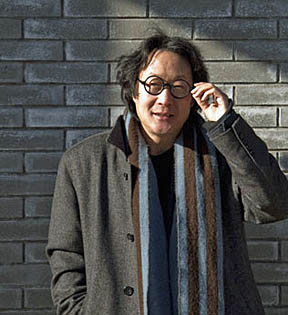
Xu Bing, 2008
Xu Bing
徐冰
Printmaker, *1955 Chongqing, Studio Brooklyn, NY, Vice President of CAFA, Beijing (2008)

Xu
Bing, 2008
Xu Bing was born in Chongqing in 1955, but moved to Beijing when Xu's father obtained a teaching position in Beijing University, where his mother worked as a librarian. At an early age, Xu frequented the libraries and was fascinated by the enormous amount of characters he did not yet recognize.
|
|
|
|
|
“Broken Jade, 1977, block prints
Xu Bing began his studies majoring in printmaker at the Central Academy of Fine Art in 1977. After finishing his undergraduate studies, Xu continued to teach in the academy, and completed an MFA in 1987.
“The Book from the
Sky”
1987-1993
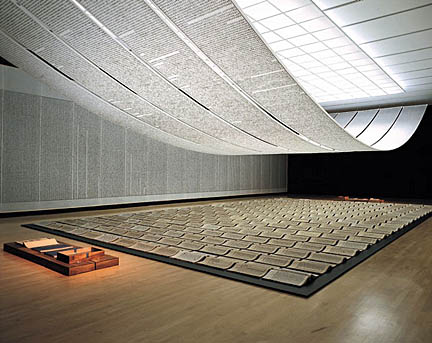
“Book
from the Sky”, 1987-1989, Scrolls bound books of Chinese
pseudo-characters
|
|
|
|
In 1987, Xu
Bing began working on the installation "Book From the Sky."
Different from the calligrapher Gu
Wenda, Xu, the printmaker, hand-cut and cast each individual
pseudo Chinese character--artificial combinations of legitimate
radicals--then printed them in Western book style and on long Chinee
scrolls. A tremendous four-year work, which appears justified only by
the Chinese reverence for their 2000 year old writing. - But
“no-sense” characters?
When Xu exhibited the first part of
the work at a solo show at the National Art Museum of China in 1988,
it became a heatedly debated topic--for its metaphorical criticism of
authority and traditional culture, as well by the sheer formal
gesture of its presentation. Shown again at the 1989 China
Avant-Garde Art Exhibition in Beijing as its largest piece of work,
the installation drew attention from both in and outside of China.
In 1990 Xu was invited to lecture at the University of Wisconsin Madison as an honorary fellow. In March 1993, Xu Bing, like Gu Wenda had already done in 1987, moved to New York City. Xu lived in Ai Weiwei's famous East Village habitat, enjoying Ai's stimulating circle of Chinese artists, directors, composers, as well as encounters with the Beat generation poet Allen Ginsberg and writer Quentin Crisp.
Xu Bing later
settled in a Brooklyn studio. Though he has traveled between New York
City and China throughout his career, he decided to return to the
Mainland im 2008 to serve as vice president of the Central Academy of
Fine Art (CAFA) in Beijing. Many regard this move to have been one of
the seminal events in China's contemporary art development.
Text
artspeakchina
The Living Word
2002
|
|
|
|
One of the prettiest examples of
Xu's method was an installation “The Living Word” (2002) at the
Smithonian in Washingto, DC. It showd the Chinese etymology of the
character niao
from
the ancient pictogram to the present “simplified” character
floating from heaven. On the right is his “English” character for
BIRD. - Again these “cryptographic” exercises appear puzzling at
best but in thrir absurdity imply a serious critique of the icons of
Chinese culture.
Xu
Bings website
The Magic Carpet
2006
Another beautiful example of Xu's philosophy is a huge red prayer carpet for the Kwan-Im Temple, the largest Buddhist Temple in Singapore.

“Magic
Carpet”, 2006, handwoven wool, 729 characters, app. 1500x1500 cm
The design of the carpet follows a
Qin Dynasty Xuan Ji Tu Rug (1620) whose 841 characters can be read in
a number of directions which form nearly 4,000 separate Buddhist
poems. Xu Bing selected passages from four significant faith-based
texts (one Buddhist, one Gnostic, one Jewish, and one passage from
Marx, all in English translation) for his carpet, which he then
transcribed into Square Word Calligraphy and synthesized into one
text.
See Xu
Bing_carpet
Bird Language
2003
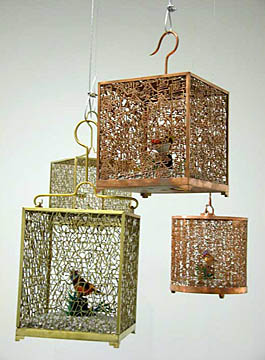
Four
Bird Cages, 2003
In a more humorous vein Xu made four
Word-Cages, each contains a 鸟,
undoubtedly made
in China for the European market. He writes:
“I
connected letters to form cages of words. The words are questions
that people have asked me about art, and my answers. Inside the cages
are toy birds that are able to revolve and emit sound. When a visitor
asks a question, the birds will respond with a bird's song.”
Xu
Bing bird language
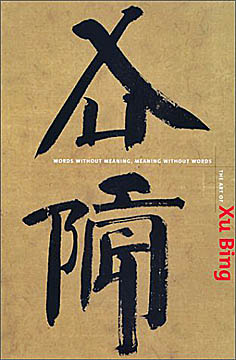
XU
BING
Xu Bing's signature in pseudo AngloSinese
And if you feel this is all for 交鸟所盎格鲁中国人
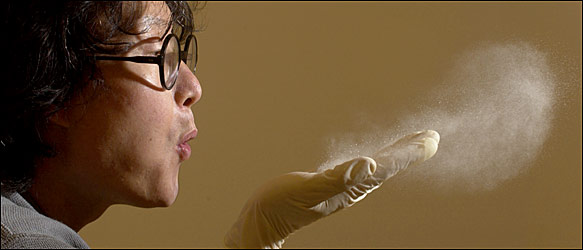
Get
yourself appointed Vice President of CAFA and blow the
dust into thin air as he did.